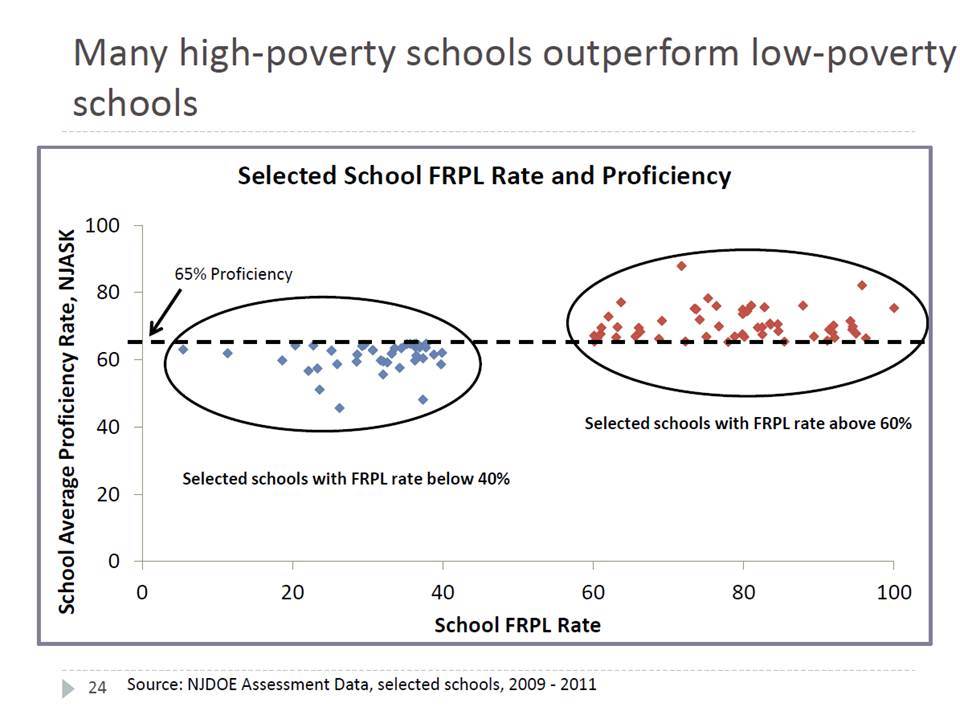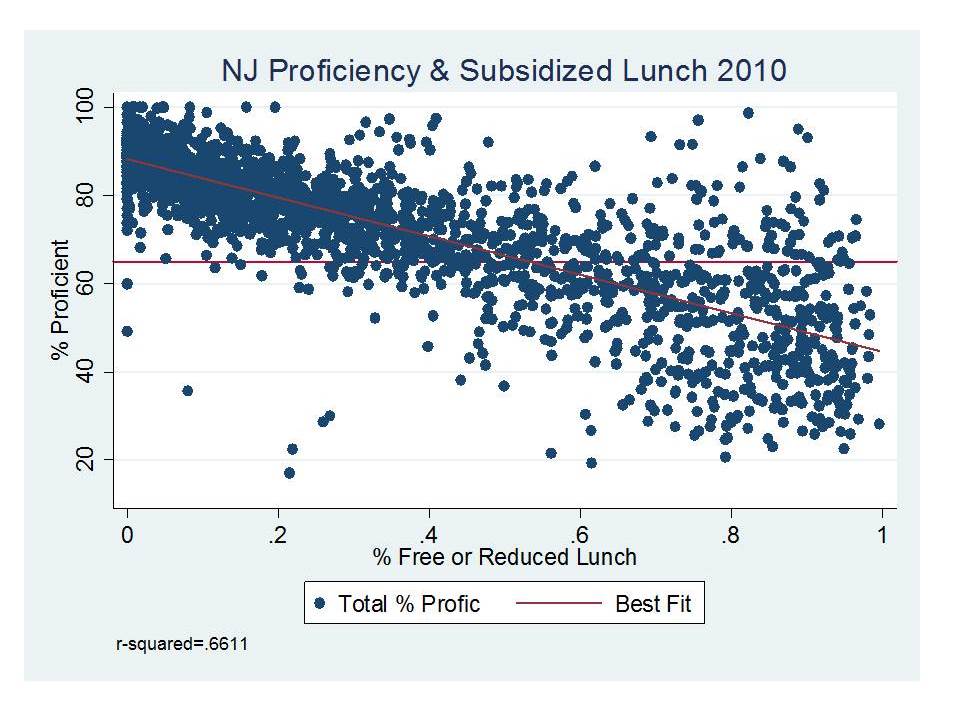On Monday, Christie’s former education commissioner Christopher Cerf, who is now running the Newark school district, told NJ.com that the governor’s funding plan would be “catastrophic” for the city. Christie said he had a “spirited discussion” with Cerf last night."Spirited," huh?
I wonder how much more "spirit" Cerf can take...
* * *
Chris Christie's "Fairness Formula" is so blatantly unfair and illogical that even Chris Cerf -- Christie's former Commissioner of Education and current State Superintendent of Newark Public Schools -- can't support it:
As I pointed out last October, this is quite a shift in thinking for Cerf. When he was in Christie's administration, he used to go around the state saying NJ's urban districts were getting way too much money:The superintendent appointed by Gov. Chris Christie to run Newark's state-controlled school district said a 60-percent cut in aid projected under a new funding formula proposed by the governor would be "catastrophic" for the district."I don't mind saying explicitly that a reduction in our budget of 60 percent would be catastrophic," said Superintendent Christopher Cerf, a former state education commissioner under Christie, who appointed Cerf to run the state's largest district last year.Cerf's comment was in response to a reporter's question about the impact on the district of a projected 60 percent cut in aid under the new Fairness Formula proposed by Christie.The formula, unveiled in June, would dole out precisely the same amount of aid per pupil — $6,599 — to all New Jersey school districts, regardless of affluence, resulting in a savings for 85 percent of the state's property taxpayers, while translating into dramatic cuts in aid to poor districts that rely on the state to fund a much higher proportion of their school budgets.An analysis by NJ Advance Media found that aid to Newark and some other poor districts would be cut by 60 percent or more under the governor's proposed formula. [emphasis mine]
Pumping more money into our worst-performing districts has provided us with moral cover, persuading us that we have met our obligation to the students in those districts while allowing us to under serve them.More money has permitted past governors and legislatures to avoid the politically difficult reforms – like implementation of an educator evaluation system, tenure reform, and ending the pernicious “last in, first out” policy – so critical to turning around our lowest-performing schools. And more money has likewise allowed the Department of Education to be satisfied with a role as district compliance-monitor rather than district partner, collaborator, and, where necessary, instigator of seismic reform. [emphasis mine]Funny how actually running a district causes you to think about this stuff a little differently, isn't it? This, among other reasons, is why I said years ago that Cerf wasn't qualified to be the Commissioner: he had never run a public school district, let alone one with many students living in poverty, so he had no idea of the challenges faced by district leaders who saw their state aid plummet under Christie.
But Cerf's flip-flopping isn't limited to school funding. The State Superintendent was interviewed last week on NJTV, where he laid out his terms for what should constitute "success" when judging the Newark schools:
Williams: Speaking of QSAC, every district in the state is governed, is tested by, is accessed by QCAS — you won’t be. Newark is going to be accessed by growth. That’s pretty broad.
Wait -- is 2016 Chris Cerf saying it's unfair to ask a district with many students in poverty to be judged by the same standards as a district with few of those students?Cerf: One of those five domains I was mentioning is called instruction in program, and that one we applied for what’s called — I’m sorry for the technical terms — an equivalency waiver. Essentially what that is is measure us by student outcomes, but measure them predominately by outcomes that are based on growth rather than absolute proficiency. [emphasis mine]
Because 2012 Chris Cerf was tired of those "excuses":
Some would say we should not put such effort into these schools. They will say these schools are low-performing because of poverty, and that until we fix community and family issues, we can’t do much better in the schools.
Of course, poverty matters. And of course, it affects a child’s experience in schools. But rather than allowing these circumstances to be used as an excuse for inaction, we should redouble our efforts as educators to make sure we do everything in our power to provide great options for these students. We have too many examples of schools and great teachers overcoming the constraints of poverty to believe we can’t do any better.
I refuse to work within a system that accepts that the circumstance into which a child is born should determine his outcome in life. And I refuse to believe that great public school teachers cannot make a difference in a child’s life.
In fact, 2012 Cerf "proved" that poverty could be overcome with his magical graph that showed poverty doesn't matter! Bruce Baker called it out in real time:Let’s work together over the next several years to give all students in New Jersey equal opportunities for success, and let’s hope that the support of expert educators in our RACs will help to turn around low-performing schools. [emphasis mine]
2012 Cerf says those red diamonds prove that schools can "overcome the restraints of poverty." Well, if that's true, 2016 Cerf, why don't you think NPS should be judged on absolute measures of student proficiency? Why should "growth" be how your schools are judged four years after you told us all "we have too many examples" of schools beating the odds?Now, it’s one thing when and under-informed tech CEO goes all TED-style on us with big screens, gadgets, bells and whistles and info-graphics that just don’t mean crap anyway. But, it’s yet another when a State Commissioner of Education presents something not only equally ridiculous… but arguably far more ridiculous, disingenuous, unethical and downright WRONG.This is a graph for the ages, and it comes from a presentation by the New Jersey Commissioner of Education given at the NJASA Commissioner’s Convocation in Jackson, NJ on Feb 29. State of NJ Schools presentation 2-29-2012The title conveys the intended point of the graph – that if you look hard enough across New Jersey – you can find not only some, but MANY higher poverty schools that perform better than lower poverty schools.This is a bizarre graph to say the least. It’s set up as a scatter plot of proficiency rates with respect to free/reduced lunch rates, but then it only includes those schools/dots that fall in these otherwise unlikely positions. At least put the others there faintly in the background, so we can see where these fit into the overall pattern. The suggestion here is that there is not pattern.Note: this graph may not even be the worst one in the presentation. You decide!The apparent inference here? Either poverty itself really isn’t that important a factor in determining student success rates on state assessments, or, alternatively, free and reduced lunch simply isn’t a very good measure of poverty even if poverty is a good predictor. Either way, something’s clearly amiss if we have so many higher poverty schools outperforming lower poverty ones. In fact, the only dots included in the graph are high poverty districts outperforming lower poverty ones. There can’t be much of a pattern between these two variables at all, can there? If anything, the trendline must be sloped uphill? (that is, higher poverty leads to higher outcomes!)Note that the graph doesn’t even tell us which or how many dots/schools are in each group and/or what percent of all schools these represent. Are they the norm? or the outliers?Well, here’s what the pattern really looks like with all schools included:Hmmm… looks a little different when you put it that way. Yeah, it’s a scatter, not a perfectly straight line of dots. And yes, there are some dots to the right hand side that land above the 65 line and some dots to the left that land below it.
I really can't think of a better example of why state and federal education policy leaders should have significant classroom and/or administrative experience before they are nominated. Not that experience guarantees they will promote good policies; however, a state commissioner who has actually been down in the trenches and understands how difficult it is to improve public schools is much less likely to indulge in fantasies about how schools will perform in the face of chronic poverty, inequality, racism, and declining funding.
If Chris Cerf ever rises to another leadership position in education policy, I hope he remembers just how tough it is to effect change in a district like Newark. I hope he won't make excuses for politicians like Chris Christie who won't give schools what the state's own law says they need. I hope he won't tut-tut at teachers and administrators who point out that while schools can and should improve, they certainly can't overcome, on their own, a host of problems they never created.
Accountability begins at home.




4 comments:
You are creating this either/or dichotomy where someone has to either support Abbott-in-Full (with $20k per student Adequacy Budgets) or Christie's so-called "Fairness Formula."
As Commissioner of Education Cerf believed that the aid targets for high-FRL districts were too high and he tried to lower Adequacy Budgets, but he never said that every district should get the same amount of aid. In 2011-12 to 2013-14, when Cerf rebuilt aid from 2010, Cerf followed progressive principles and gave more money to under-Adequacy districts. In fact, Cerf was way in front of everyone else in condemning Adjustment Aid in 2012-13 actually redistributed over $40 million.
Flash forward a few years and Cerf is in charge of the Newark schools. Due to flat state aid, minimal increases in local taxes, and transfers to charters, Newark's budget per pupil is lower than where Cerf wanted it to be back in 2012.
Has Cerf changed somewhat? Maybe. But there's no massive change.
I also haven't seen Cerf make an argument that Newark and "urban" poor districts (ie, Abbotts) should be NJ's aid priority. I haven't seen Cerf suggest anything in the way that Newark should take priority in state aid over Atlantic City, Dover, Belleville, Bound Brook, Prospect Park etc.
To clarify, there isn't an either/or dichotomy. Someone can have a middle of the road perspective. That's where Cerf is.
Cerf would agree with you that $8 k per student in Newark would be cataclysmic, but $21k per student (which is SFRA/Abbott) is excessive.
Jeff, you are way too nice here.
Chris Cerf stood by Christie's side as he underfunded the entire system year after year. His job was to justify the aid cuts across the state by saying the "real" problem was tenure, not enough charters, teacher evaluation, the NJEA, etc.
Cerf never knew what it was like to try to educate kids when the governor kept slamming your district while simultaneously cutting your funding. Well...
Welcome to the party, pal.
If Cerf is actually making sense and contradicting clueless politicians that appointed him, he might not get another such appointment.
Post a Comment